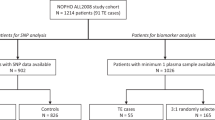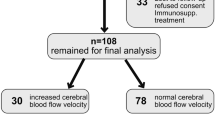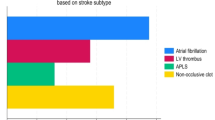Abstract
We report a normotensive case of reversible posterior leukoencephalopathy syndrome caused by transient hypercoagulable state. Hypertension is the main risk factor for reversible posterior leukoencephalopathy syndrome, which is believed to occur as a result of high blood pressure-related dysfunction of cerebrovascular endothelial cells, because it commonly appears in hypertensive emergency. However, in this completely normotensive case, the typical clinical findings of reversible posterior leukoencephalopathy syndrome were triggered by transient hypercoagulable state without any blood pressure variation. The case was successfully treated with anticoagulation therapy using heparin. Thus, this case indicates that reversible posterior leukoencephalopathy syndrome is induced by cerebrovascular endothelial dysfunction, which is induced not only by high blood pressure but also hemostatic dysfunction.
Similar content being viewed by others
Article PDF
References
Hinchey J, Chaves C, Appignani B, et al: A reversible posterior leukoencephalopathy syndrome. N Engl J Med 1996; 334: 494–500.
Eguchi K, Kasahara K, Nagashima A, et al: Two cases of malignant hypertension with reversible diffuse leukoencephalopathy exhibiting a reversible nocturnal blood pressure “riser” pattern. Hypertens Res 2002; 25: 467–473.
Yong PF, Hamour SM, Burns A : Reversible posterior leukoencephalopathy in a patient with systemic sclerosis/systemic lupus erythematosus overlap syndrome. Nephrol Dial Transplant 2003; 18: 2660–2662.
Bakshi R, Shaikh ZA, Bates VE, Kinkel PR : Thrombotic thrombocytopenic purpura: brain CT and MRI findings in 12 patients. Neurology 1999; 52: 1285–1288.
Verma S, Anderson TJ : Fundamentals of endothelial function for the clinical cardiologist. Circulation 2002; 105: 546–549.
Bonetti PO, Lerman LO, Lerman A : Endothelial dysfunction: a marker of atherosclerotic risk. Arterioscler Thromb Vasc Biol 2003; 23: 168–175.
Furumoto T, Saito N, Dong J, Mikami T, Fujii S, Kitabatake A : Association of cardiovascular risk factors and endothelial dysfunction in Japanese hypertensive patients: implications for early atherosclerosis. Hypertens Res 2002; 25: 475–480.
Tomiyama H, Kushiro T, Okazaki R, Yoshida H, Doba N, Yamashina A : Influences of increased oxidative stress on endothelial function, platelets function, and fibrinolysis in hypertension associated with glucose intolerance. Hypertens Res 2003; 26: 295–300.
On YK, Kim CH, Oh BH, Lee MM, Park YB : Effects of angiotensin converting enzyme inhibitor and calcium antagonist on endothelial function in patients with essential hypertension. Hypertens Res 2002; 25: 365–371.
Dong J, Fujii S, Goto D, et al: Increased expression of plasminogen activator inhibitor-1 by mediators of the acute phase response: a potential progenitor of vasculopathy in hypertensives. Hypertens Res 2003; 26: 723–729.
Dohi Y, Ohashi M, Sugiyama M, Takase H, Sato K, Ueda R : Circulating thrombomodulin levels are related to latent progression of atherosclerosis in hypertensive patients. Hypertens Res 2003; 26: 479–483.
Targonski PV, Bonetti PO, Pumper GM, Higano ST, Holmes DR Jr, Lerman A : Coronary endothelial dysfunction is associated with an increased risk of cerebrovascular events. Circulation 2003; 107: 2805–2809.
Perticone F, Ceravolo R, Pujia A, et al: Prognostic significance of endothelial dysfunction in hypertensive patients. Circulation 2001; 104: 191–196.
Okura Y, Takao M, Zhang B, Nakashima Y, Saku K : Cardiovascular risk factor profiles and endothelial function in coronary artery disease patients treated with statins. Hypertens Res 2004; 27: 723–729.
Iseki K, Kimura Y, Wakugami K, et al: Comparison of the effect of blood pressure on the development of stroke, acute myocardial infarction, and end-stage renal disease. Hypertens Res 2000; 23: 143–149.
Sacco RL, Ellenberg JH, Mohr JP, et al: Infarcts of undetermined cause: the NINCDS Stroke Data Bank. Ann Neurol 1989; 25: 382–390.
Li C, Engstrom G, Hedblad B, Berglund G, Janzon L : Risk factors for stroke in subjects with normal blood pressure: a prospective cohort study. Stroke 2005; 36: 234–238.
Casey SO, Sampaio RC, Michel E, Truwit CL : Posterior reversible encephalopathy syndrome: utility of fluid-attenuated inversion recovery MR imaging in the detection of cortical and subcortical lesions. Am J Neuroradiol 2000; 21: 1199–1206.
Eichler FS, Wang P, Wityk RJ, Beauchamp NJ Jr, Barker PB : Diffuse metabolic abnormalities in reversible posterior leukoencephalopathy syndrome. Am J Neuroradiol 2002; 23: 833–837.
Rosenberg RD, Aird WC : Vascular-bed–specific hemostasis and hypercoagulable states. N Engl J Med 1999; 340: 1555–1564.
Brown RC, Davis TP : Calcium modulation of adherens and tight junction function: a potential mechanism for blood-brain barrier disruption after stroke. Stroke 2002; 33: 1706–1711.
Wardlaw JM, Sandercock PA, Dennis MS, Starr J : Is breakdown of the blood-brain barrier responsible for lacunar stroke, leukoaraiosis, and dementia? Stroke 2003; 34: 806–812.
Goldstein LB, Adams R, Becker K, et al: Primary prevention of ischemic stroke: a statement for healthcare professionals from the Stroke Council of the American Heart Association. Stroke 2001; 32: 280–299.
Warlow C, Sudlow C, Dennis M, Wardlaw J, Sandercock P : Stroke. Lancet 2003; 362: 1211–1224.
Kario K, Matsuo T, Hoshide S, Umeda Y, Shimada K : Effect of thrombin inhibition in vascular dementia and silent cerebrovascular disease. An MR spectroscopy study. Stroke 1999; 30: 1033–1037.
Schachna L, Wigley FM : Targeting mediators of vascular injury in scleroderma. Curr Opin Rheumatol 2002; 14: 686–693.
Ay H, Buonanno FS, Schaefer PW, et al: Posterior leukoencephalopathy without severe hypertension: utility of diffusion-weighted MRI. Neurology 1998; 51: 1369–1376.
Author information
Authors and Affiliations
Corresponding author
Rights and permissions
About this article
Cite this article
Yano, Y., Kario, K., Fukunaga, T. et al. A Case of Reversible Posterior Leukoencephalopathy Syndrome Caused by Transient Hypercoagulable State Induced by Infection. Hypertens Res 28, 619–623 (2005). https://doi.org/10.1291/hypres.28.619
Received:
Accepted:
Issue date:
DOI: https://doi.org/10.1291/hypres.28.619



